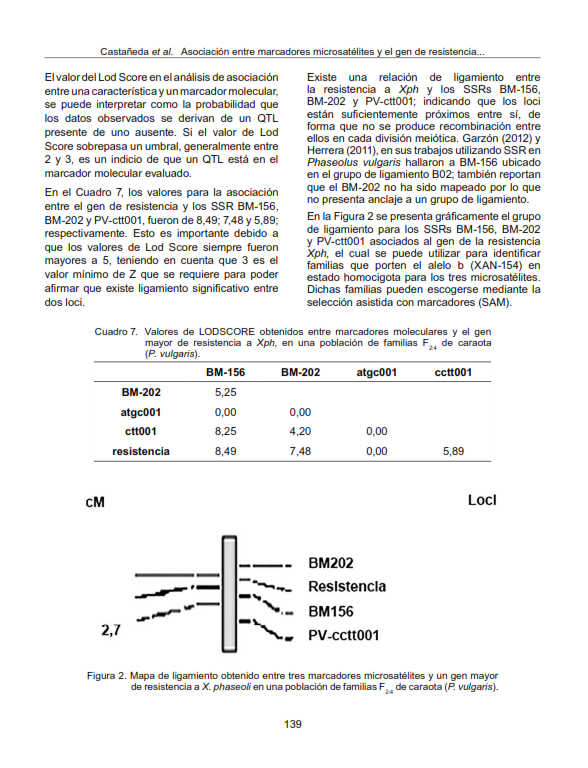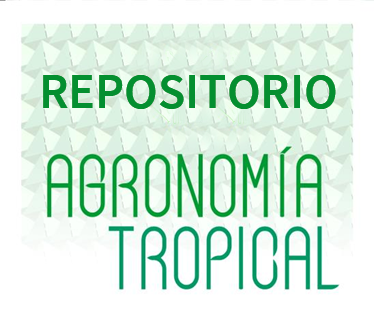Association between microsatellite markers and the resistance gene to common bacterial blight in F 2:4 families of Phaseolus vulgaris L.
Abstract
The incidence of disease is one of the factors limiting the production of black bean (Phaseolus vulgaris L.). The common bacterial blight of bean caused by Xanthomonas phaseoli (Xph) is the most important crop bacterial disease because reduces grain yield by 45% and also affects the quality of the seed. It is necessary to incorporate resistance genes through crossing programs. The object of this study was to verify the association between type microsatellite molecular markers (SSR) and the resistance gene to common bacterial blight in families F 2:4 of black bean. The molecular evaluation was performed usig the molecular amplification primers PV-ctt001, PV-atgc001, BM-140, BM-156, and BM-202, that has previously showed a possible association with resistance. For amplification of SSR, the standardized in the conditions in the molecular genetics laboratory were used. Expected segregation of F 2:4 families for each SSR was verified using MapDisto Genetics V 6.3 program. BM-140 behaved as a monomorphic marker and VPV-ctt001, as an independent locus, so it was not possible to differentiate between resistant families using these markers. Significant association between SSR: BM-156, BM-202 and resistance controlled by a dominant gene in families F2:4 was found Xph marker and PV-atgc001 as an independent locus used. Assisted selection to the “b” allele using these SSR will be useful to identify plants carrying the resistance in black bean breeding programs
Downloads
References
• Cruz, S., P. Ramírez, R. García, F. Castillo y J. Sandoval. 2004. Selección para la resistencia al tizón común en frijol. Revista Fitotecnia Mexicana. 27(2):141-147.
• Cruz, S., P. Ramírez, B. Tlapal, I. Ramírez, R. García, J. Sandoval y F. Castillo. 2001. Producción masiva de Xanthomonas axonodopis pv. phaseoli (Smith). Agrociencia. 35:575-581.
• Gaitán, E., M. Duque, K. Edwards and J. Tohme. 2002. Microsatellite Repeats in Common Bean (Phaseolus vulgaris): Isolation, Characterization, and Cross-Species Amplification in Phaseolus ssp. Crop Science. 42:2128-2136.
• Gepts, P. and M. Clegg. 1989. Genetic Diversity in Pearl Millet (Pennisetum glaucum) [L.] R. Br.) at the DNA Sequence Level. The Journal of Heredity. 80(3):203-208.
• Herrera, N. 2011. Saturación del mapa genético de una población intra-acervo de fríjol (Phaseolus vulgaris L.) empleando marcadores moleculares tipo SSR y SSCP. Trabajo de grado para optar al título de bióloga. Universidad del Quindío. Facultad de Ciencias Básicas y Tecnologías. Colombia. 122 p.
• Jung, G., P. Skroch, D. Coyne, J. Nienhuis, E. Arnaud, H. Ariyarathne, S. Kaeppler and M. Basset. 1997. Molecular-marker based genetic analysis of tepary bean derived common bacterial blight resistance in different developmental stages of common bean. Journal of the American Society for Horticultural Science. 122(3):329-337.
• Jung, G., D. Coyne, P. Kroch, J. Nienhuis, E. Arnal, J. Bokosi, S. Kaeppler, and J. Steandman. 1994. Construction of a genetic linkage map and location of common blight, rust resistance and pubescence loci in Phaseolus vulgaris L. using amplified polymorphic DNA (RAPD) markers. Bean Improvement Cooperative. 37:37-38.
• Lagarde, P., A. Medina, C. Ramis y A. Maselli. 2010. Evaluación de la resistencia a la bacteriosis común causada por Xanthomonas phaseoli en plantas F3 de caraota (Phaseolus vulgaris). Fitopatología Venezuela. 23(2):35-39.
• Lara, L. 2012. Evaluación del gen circumlineatus en la semilla de frijol común (Phaseolus vulgaris) con marcadores moleculares microsatélites. Proyecto especial de graduación del programa de Ingeniería Agronómica. Escuela Agrícola Panamericana. Zamorano, Honduras. 17 p.
• Maselli, A., L. Rosales y Y. Guevara. 2006. Uso de extractos vegetales sobre Xanthomonas phaseoli, causante de la quemazón en Phaseolus vulgaris L. CENIAP HOY, N° 12.
• Mekbib, F. 2003. Yield stability in common bean (Phaseolus vulgaris L.) genotypes. Euphytica. 130:147-153.
• Miklas, P., E. Johnson, V. Stone, J. Beaver, C. Montoya and M. Zapata. 1996. Selective mapping of QTL conditioning disease resistance in common bean. Crop Science. 36:1344-1351.
• Mutlu, N., K. Vidaver, D. Coyne, J. Steadman, P. Lambrecht and J. Reiser. 2008. Differential Pathogenicity of Xanthomonas campestris pv. phaseoli and X. fuscans subsp. fuscans Strains on Bean Genotypes with Common Blight Resistance. Published by The American Phytopathological Society. Plant Disease. 92(4):546-554.
• Murray, M. and W .Thompsom. 1980. Rapid isolation of high molecular weight DNA. Nucleic Acids Reporter. 8:4321-4325.
• Mwale, M., J. Bokosi, C. Masangano, M. Kwapata, V. Kabambe and C. Miles. 2008. Yield Park, S., A. Dursun, D. Coyne and G. Jung. 1996. Identification of RAPD markers linked to major genes for common bacteria. Annual Report Bean Improvement Cooperative. 39:128-129.
• Ramis, C., A. Medina, A. Maselli, M. Pérez, O. Movil, L. Salazar, J. Jiménez, A. Bedoya, M. Gutiérrez, D. Pérez y M. Gutierrez. 2007. Informe final del subprograma: Búsqueda de marcadores moleculares asociados a la resistencia a la bacteriosis común (Xanthomonas phaseoli) en caraota. BID-FONACIT II; Instituto Nacional de Investigaciones Agrícolas INIA-CENIAP, Laboratorio de Bacteriología; Universidad Central de Venezuela, Facultad de Agronomía, Centro de Investigación en Biotecnología Agrícola (CIBA). Maracay, Venezuela.
• Santos, A., R. Bressan, M. Pereira, R. Rodrigues and C. Ferreira. 2003. Genetic Linkage Map of Phaseolus vulgaris and Identification of QTLs Responsible for Resistance to Xanthomonas axonopodis pv. phaseoli. Fitopatología Brasileira (jan-fev). 28(1):5-10.
• Salomón, J. 2002. Evaluación y selección de performance of dwarf bean (Phaseolus familias F en F de caraota (Phaseolus vulgaris L.) lines under Researcher Designed Farmer Managed (RDFM) system in three bean agro-ecological zones of Malawi. African Journal of Biotechnology. (16):2847-2853.
• Nodari, R., S. Tsai, P. Guzman, R. Gilbertson and P. Gepts. 1993. Towards an integrated linkage map of common bean. Mapping genetic factors controlling host-bacteria interactions. Genetics. 134:341-350.
• Nunes, W., M. Corazza, S. Dias, S. Mui and E. Kuramae. 2008. Characterization of Xanthomonas axonopodis pv. phaseoli isolates. Summa Phytopathologica. Botucatu, Brasil. 34(3):228-231.
• Yu, K., S. Park, V. Poysa and P. Gepts. 2000. Integration of Simple Secuence Repeat (SSR) Markers Into a Molecular Linkage Map of Common Bean (Phaseolus vulgaris L.) The American Genetic Association. 91:429-434.
• Yu, Z., R. Stall and C. Vallejos. 1998. Detection of genes for resistance to common bacterial blight of beans. Crop Science. 38:1290-1296.





